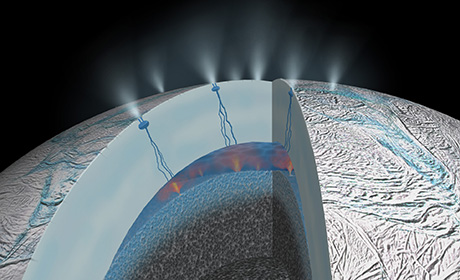Saturn Moon’s Ocean May Have Hydrothermal Activity
11 March 2015

Source: NASA/JPL-Caltech
Saturn’s moon Enceladus may have hydrothermal activity, which increases the probability that it could host suitable environments for living organisms. The new data analyses from the Cassini-Huygens mission, a European-American collaboration that includes scientists from Heidelberg University and the University of Stuttgart, point to this finding. The microscopic grains of rock the scientists detected near Saturn are the first clear indication of any icy moon having hydrothermal activity. In this process, seawater infiltrates and reacts with the rocky crust and emerges as a heated, mineral-laden solution. The results of the research were published in the journal Nature.
The Cassini-Huygens mission to study the gaseous planet Saturn and its moons was launched in 1997 by NASA, ESA and the Italian Space Agency ASI and comprises the Cassini orbiter and the Huygens atmospheric probe. In 2005, the mission first revealed geologic activity on Enceladus with evidence of icy geysers. Results of investigations in Enceladus’ gravitational field published in 2014 strongly suggest the presence of a 10-kilometre-deep ocean beneath an ice shell 30 to 40 kilometres thick. The new results follow an extensive four-year analysis of data from the Cassini Cosmic Dust Analyzer as well as computer simulations and laboratory experiments. Cassini had repeatedly detected tiny particles of rock that contained silicon and orbited Saturn at the same distance as Enceladus.
By the process of elimination, the researchers concluded that these particles must be grains of silica, which is found on Earth in sand and the mineral quartz. The consistent size of the grains – the largest of which were six to nine nanometres – was the clue that a specific process was likely responsible. On Earth, the most common way for silica grains of this size to form is hydrothermal activity involving a specific range of conditions, namely when alkaline water with modest salinity that is super-saturated with silica undergoes a big drop in temperature. “We methodically searched for alternative explanations for the tiny silica grains, but every new result pointed to a single, most likely origin,” explains Dr. Frank Postberg, the study’s co-author. He conducts research and teaches at the Institute of Earth Sciences of Heidelberg University and the Institute of Space Systems of the University of Stuttgart.
The scientists demonstrated that the small grains most likely form when hot water with dissolved minerals travels upward from the moon’s rocky interior and comes into contact with cold water. Temperatures of at least 90 degrees Celsius are needed to support the interactions that produce the tiny grains. The scientists assume that these conditions exist on the seafloor of Enceladus, where hot water from the interior meets the relatively cold water at the ocean bottom. “It's very exciting that we can use these tiny grains of rock, spewed into space by geysers, to tell us about conditions on – and beneath – the ocean floor of an icy moon,” says Sean Hsu of the University of Colorado at Boulder (USA), first author of the study, who earned his doctorate at the Institute of Earth Sciences of Heidelberg University. The extremely small size of the silica particles also suggests that they travel upward relatively quickly from their hydrothermal origin to the near-surface sources of the moon's geysers. From seafloor to outer space, a distance of about 50 kilometres, the grains spend a few months to a few years in transit, otherwise they would grow to much larger sizes.
The Cassini-Huygens mission began on 15 October 1997 and reached Saturn after a flight of just under seven years. In Germany, the German Aerospace Centre (DLR), institutes of the Max Planck Society, several universities and the German space industry are participating in the mission. Dr. Ralf Srama of the Institute of Space Systems at the University of Stuttgart is coordinating the scientific planning and mission operations.
Original publication:
S. Hsu, F. Postberg, et al.: Ongoing hydrothermal activities within Enceladus. Nature (12 March 2015), doi:10.1038/nature14262

